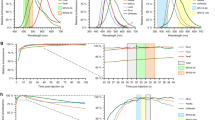Abstract
Reporter gene assays are critical tools of nuclear receptor research for characterizing the effects of ligands on nuclear receptor activity. Common luciferase-based techniques require expensive substrates and are typically performed in endpoint format. Here, we describe a versatile reporter gene assay to observe nuclear receptor activity with fluorescent proteins as reporters. This setting is highly cost-efficient and enables observation of nuclear receptor activity over time with multiple measurements from one plate.
Access this chapter
Tax calculation will be finalised at checkout
Purchases are for personal use only
Similar content being viewed by others
References
Germain P, Staels B, Dacquet C, Spedding M, Laudet V (2006) Overview of nomenclature of nuclear receptors. Pharmacol Rev 58:685–704. https://doi.org/10.1124/pr.58.4.2
Aranda A, Pascual A (2001) Nuclear hormone receptors and gene expression. Physiol Rev 81:1269–1304
Benoit G, Cooney A, Giguere V, Ingraham H, Lazar M, Muscat G, Perlmann T, Renaud JP, Schwabe J, Sladek F, Tsai MJ, Laudet V (2006) International union of pharmacology. LXVI. Orphan nuclear receptors. Pharmacol Rev 58:798–836. https://doi.org/10.1124/pr.58.4.10
Merk D, Steinhilber D, Schubert-Zsilavecz M (2014) Characterizing ligands for farnesoid X receptor-available in vitro test systems for farnesoid X receptor modulator development. Expert Opin Drug Discov 9:27–37. https://doi.org/10.1517/17460441.2014.860129
Heering J, Merk D (1966) Hybrid reporter gene assays: versatile in vitro tools to characterize nuclear receptor modulators. Methods Mol Biol 2019:175–192. https://doi.org/10.1007/978-1-4939-9195-2_14
Gellrich L, Heitel P, Heering J, Kilu W, Pollinger J, Goebel T, Kahnt A, Arifi S, Pogoda W, Paulke A, Steinhilber D, Proschak E, Wurglics M, Schubert-Zsilavecz M, Chaikuad A, Knapp S, Bischoff I, Fürst R, Merk D (2020) L-thyroxin and the nonclassical thyroid hormone TETRAC are potent activators of PPARÎ. J Med Chem 63:6727–6740. https://doi.org/10.1021/acs.jmedchem.9b02150
Author information
Authors and Affiliations
Corresponding author
Editor information
Editors and Affiliations
Rights and permissions
Copyright information
© 2023 The Author(s), under exclusive license to Springer Science+Business Media, LLC, part of Springer Nature
About this protocol
Cite this protocol
Schallmayer, E., Merk, D. (2023). A Fluorescence-Based Reporter Gene Assay to Characterize Nuclear Receptor Modulators. In: Merk, D., Chaikuad, A. (eds) Chemogenomics. Methods in Molecular Biology, vol 2706. Humana, New York, NY. https://doi.org/10.1007/978-1-0716-3397-7_9
Download citation
DOI: https://doi.org/10.1007/978-1-0716-3397-7_9
Published:
Publisher Name: Humana, New York, NY
Print ISBN: 978-1-0716-3396-0
Online ISBN: 978-1-0716-3397-7
eBook Packages: Springer Protocols




